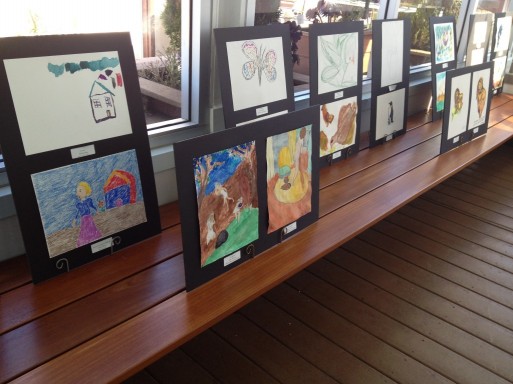Constance Hunt is an art therapist working at the AgeSong Institute, located in San Francisco, CA. AgeSong is an eldercare facility committed to shifting the typical perspective on aging by bringing greater acceptance and respect to end-of-life care. In her role as Enrichment Coordinator, Constance provides a wide range of art therapy based activities that are adapted specifically for the elders in the AgeSong community.
Hannah: Tell us a little bit about AgeSong and the work you do there.
Constance: Nader Shabahangi, the founder of AgeSong, had gone to an assisted living place and saw that the residents sitting there not engaged. He thought, “These are the elders, these are supposed to be the ones that we respect and learn from and who pass on their wisdom.” So he and his brothers decided to buy a building and put a different face on aging. One of the things that makes AgeSong unusual is that we have psychology interns here. They are trained in the [specific] philosophy that is used here, which is existential, humanistic and person-centered.
I have a co-worker in the Enrichment Program, and we both work as Enrichment Coordinators. I came to AgeSong in 2004, so I was trained here, but I’m also a registered art therapist. My co-worker and I lead a variety of groups with residents. Our program is five-pronged to incorporate cognitive, social, physical, creative arts and spiritual components. We create the calendar and implement the programming here and invite residents to join us. Activities include games and poker, outdoor walks, scenic drives, seated tai chi, meditation groups [and] music groups. Since 2007, there has been at least one art show a year — because t is important to celebrate and witness the work of the residents.
Hannah: What is art therapy?
Constance: The concept is made up of two words — art and therapy. Accordingly, the art therapist is skilled and studied in both the art and the therapy. An art therapist is trained to work with with a variety of populations, issues, assessments, theories and materials.
The American Art Therapy Association’s statement says, and I quote, “Art therapy is based on the belief that the creative process involved in the making of art is healing and life-enhancing. Through creating art and talking about art and [its] process with an art therapist, one can increase awareness of self, cope with symptoms, stress and traumatic experiences, enhance cognitive abilities and enjoy the life-affirming pleasures of artistic creativity.”
“Through creating art and talking about art and [its] process with an art therapist, one can increase awareness of self, cope with symptoms, stress and traumatic experiences…”
Here, I mainly use adaptive art therapy. [That] means that I adapt the directive and the materials to an individual’s needs.
Hannah: What can a client expect in an art therapy session? What types of media are used?
Constance: That depends on what [subject matter] the person came to the art therapy session to process. The first step is to create a safe environment in which the person can begin to process and to respect the client and trust the process. I use many types of media, all non-toxic and safe. Examples include fabric, crayons, watercolors, paper, pencils, pastels, Model Magic clay, drumming, music, collage, storytelling, sand trays, origami and more.
Hannah: How can your work support those who are confronting death and dying?
Constance: I led a Grief Group for over a year and now we have an intern leading a Grief and Loss Group once a week. We also have rituals in place for when a resident dies. We consult the family or significant other beforehand, to see if this is something they would appreciate. If so, we provide a Rose Petal ceremony and a Time of Remembrance [ceremony]. We place a photo and candle of the person who has died at our front desk.
“I believe we are all artists and know how to make marks.”
Before the Rose Petal Ceremony, we gather residents and staff to inform them of the death and invite them to participate. As the body leaves, those who wish to honor the person’s life gather in a line and place rose petals on the body as it passes by. A singing bowl is also rung as the person leaves the facility. We also ask the family if they would like to be part of a Time of Remembrance with the residents. We choose a time when interns and staff are available to participate and create a surface on which we can place items the person has created with us, as well as photos and art, music, or poetry that the resident liked. Residents and staff are encouraged to speak and share memories. We honor the person very specifically.
Hannah: What are some common misconceptions about art therapy? Does a person need to be an artist to take part?
Constance: Some common misconceptions are that art therapy is just child’s play, that anyone can practice art therapy without first being trained — and that one needs to already be a skilled artist to take part. I believe we are all artists and know how to make marks.
Hannah: Thank you for speaking with us, Constance!
Constance: Thank you.
Related Links:
- An Interview with Dr. Nader Shabahangi
- AgeSong Resident Artwork
- American Art Therapy Association

 What is Art Therapy? An Interview with Constance Hunt
What is Art Therapy? An Interview with Constance Hunt




 John Mulaney’s “Funeral Planning” on Netflix: No Real Plan
John Mulaney’s “Funeral Planning” on Netflix: No Real Plan

 Composting Bodies Is Now Legal in a Dozen States
Composting Bodies Is Now Legal in a Dozen States














